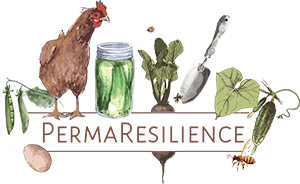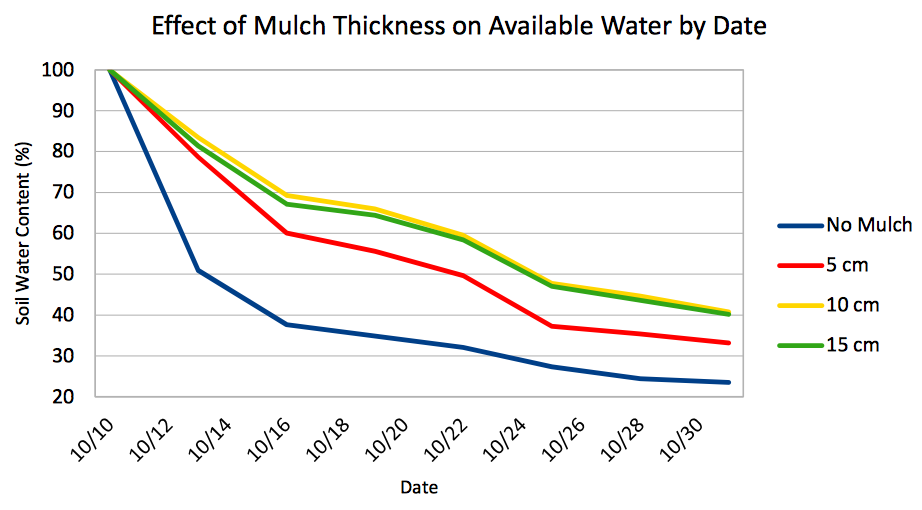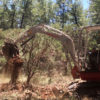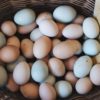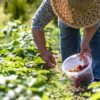As a Grass Valley permaculture consulting service the topic of drought mitigation is always important – especially with the current drought conditions we are experiencing in Northern California.
Mulching with organic matter has many benefits that make it worth while even without drought conditions and yet it is a simple and cheep action most anyone can use to reduce water use, water needs and water loss on any property.
Drought Mitigation
It is debatable as to if we can do anything to mitigate the actual drought – certainly this topic of climate change is a big one and one this articles does not aim to address. Rather, the point here is to help mitigate the issue today and locally – starting with each of our properties.
Water is a very unique resource and one that we often take for granted; we pipe it all over the place, use it to pass bodily functions in, wash cars and many other ‘wasteful’ activities. Among many of the things we need to do differently with water the focus here is using mulch in the garden, on the farm and in the landscape to help mitigate the effects of drought by retaining soil moisture and reducing water use.
Type of Mulch
By mulching I am meaning a layer of organic matter on top of bare soil – this can be straw, grass clippings, pine needles, shredded mulch, tree chipping to name a few. I am not advocating plastic mulches as they do little for improving the soil whereas organic mulch help build the quality of the soil and provide habitat for beneficial insects, funguses and bacteria. In addition plastic mulches use petroleum resources and break down to pollute the environment.
Mulch materials can be obtained from your local landscape supply store – be sure to check and see how sustainably these materials have been harvest and from how far away. Keeping things as local as possible is key.
Alternatively tree companies often dump their loads of tree chipping for free or near free if you call and ask. Some counties even have local dump sites where you can go and collect mulch for free – this is the case here in Grass Valley.
Often your property has mulch material available in the form of weeds, grass clippings, tree prunings and more if you are creative.
Soil Moisture Retention
By using a layer of mulch at least 2″ thick on top of any bare soil you will provide a barrier between the harsh sun and the soil – reducing the amount of evaporation. Check out this study reporting the change in moisture loss based off the depth of mulch:
You can read the entire study here.
The study clearly demonstrated that mulching with at least a 5 cm layer reduces soil surface evaporation, even using the 0.01 significance level, (p = 0.0089). This was especially the case at the beginning of the study, when the soil was fully saturated. In the first 3 days, a mulch layer of at least 5 cm reduced surface evaporation to 40% compared to the water losses from bare soil.
And of course there are a myriad of soil moisture retention studies relating to mulch if you google them and they all say the same thing – mulching works to retain soil moisture.
I feel this applies from home landscapes to homestead gardens all the way to farms. There are farms in the area that I have seen starting to bring more mulch onsite to help combat water use issues and that is fantastic.
Reduced Water Use
By your soil and plants needing less water you then are required to water less. This should be a no brainer as it is conserving a limited resource and will in the long term save you money by reducing watering costs. Enough said.
Building The Soil
A by-product of the mulching is improving the quality of your soil – the materials will break down slowly and add carbon, some nitrogen and organic elements to the soil. Basically composting in place. If you ever grab a handful of thick mulch you will see that it is home to so many other beneficial insects such as worms and decomposers that are doing many things for your soil and garden – building the quality of the soil by breaking down organic matter and building a fungal mat to help plants assimilate nutrients to name just a couple.
Weed Suppression
Yup, just another by-product of mulching, a lot less weeding. Don’t worry though as a few weeds will get though so the few that say “I enjoy weeding my garden” will still get some of that satisfaction.
Mulch & Permaculture
One of the permaculture ethics is people care – we need to be sure to care for each other. I have heard that Native cultures often made decisions based off how they would impact the next 7 generations. Yes, seven. I feel we need to think similar to this and not just consume however much water we choose to or consume additional amounts just because it is convenient.
At the rate we are consuming our fresh water supply how many generations down the road will have major water shortage to deal with – two? Maybe one?
I’d like to think that we can change this thinking and be more forward looking – to ensure our actions both serve us in the current and those in the future. There are many steps we can take today that serve both and reducing water use with mulch both helps mitigate the effects of drought and helps preserve water and build soil for future generations.
Permaculture Consulting
Interested in High Sierra Permaculture’s permaculture consulting? We offer onsite services for Grass Valley and much of Northern California – contact us!
